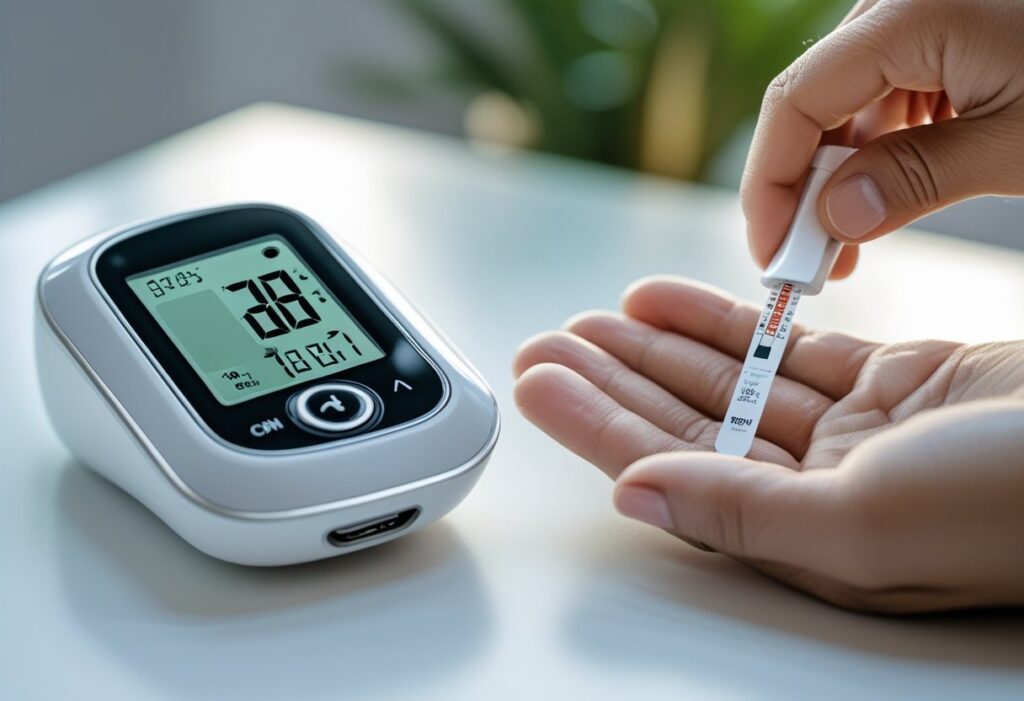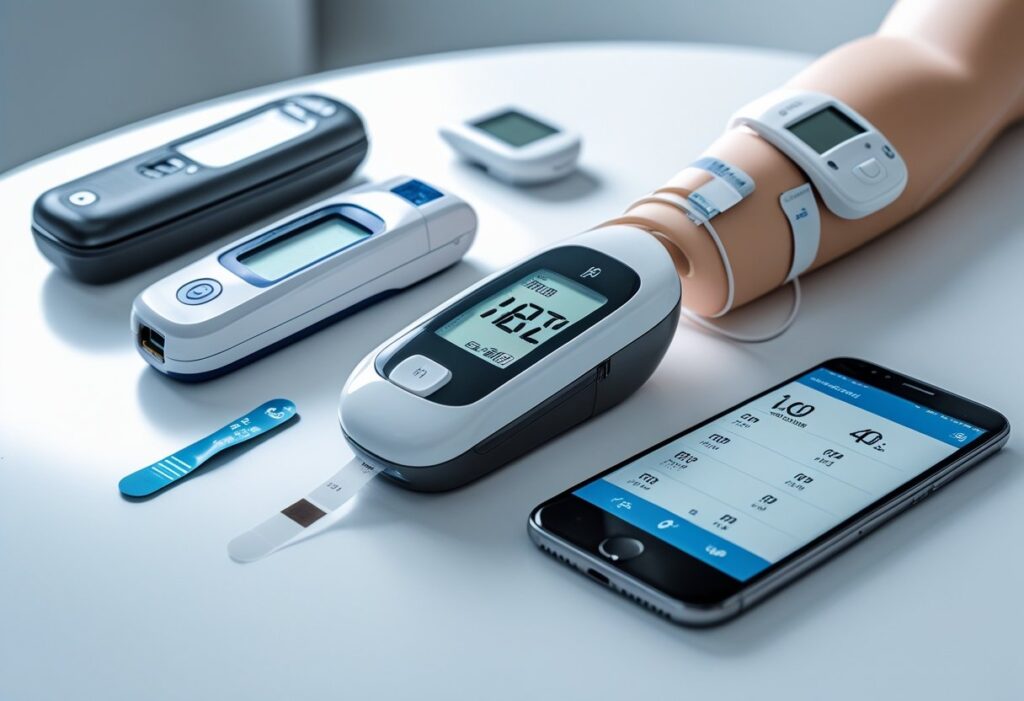Glucose monitors are devices that help people keep track of their blood sugar levels. They are essential for those with diabetes or prediabetes, allowing them to manage their condition and avoid dangerous spikes or drops in glucose. The most reliable way to monitor blood sugar is by using either a blood glucose meter or a continuous glucose monitor (CGM), depending on personal needs.

A blood glucose meter requires finger-prick tests, giving quick results at specific times. Meanwhile, CGMs provide continuous, real-time data by tracking glucose under the skin. This continuous monitoring helps users spot patterns and make better decisions about their health.
Choosing the right glucose monitor depends on lifestyle, budget, and medical advice. Understanding the available options allows people to better control their diabetes and improve overall well-being. Learn more about the benefits and features of different devices to find the best fit. More details on best glucose monitors.
What Are Glucose Monitors?

Glucose monitors measure the amount of sugar in the blood. They help people track their blood sugar levels to manage health conditions like diabetes. These devices come in different forms and offer times when blood sugar is high or low.
Definition and Overview
A glucose monitor is a device that measures blood sugar levels. The most common type is a glucose meter, which uses a small blood sample, usually from a finger prick. Users place the blood on a test strip, and the meter displays the glucose level.
There are also continuous glucose monitors (CGMs). These devices use a small sensor under the skin to track glucose levels throughout the day. CGMs send real-time data to a display device or smartphone. Some monitors are noninvasive, measuring glucose without piercing the skin, but they are less common.
Purpose of Blood Glucose Monitoring
Blood glucose monitoring is essential for managing diabetes. It helps users understand how food, exercise, and medication affect their blood sugar. Monitoring prevents dangerous highs (hyperglycemia) or lows (hypoglycemia).
Regular checks support better control of blood sugar levels, lowering the risk of complications like nerve damage, kidney issues, and heart disease. For people without diabetes, glucose monitoring isn’t usually necessary unless advised by a doctor.
Who Should Use Glucose Monitors?
People with type 1 or type 2 diabetes are the primary users of glucose monitors. Those with prediabetes or gestational diabetes may also use them to keep track of blood sugar changes.
Doctors may recommend glucose monitors for people on medications that affect blood sugar or those who have symptoms of abnormal glucose levels. Continuous glucose monitors are helpful for people needing constant tracking, such as those with unstable diabetes.
For casual monitoring, traditional meters may be enough, but CGMs provide more detailed data for serious management. Choosing the right type depends on medical needs and lifestyle.
Learn more about different types of glucose monitors and their uses at Healthline’s page on the 7 Best Glucose Monitors 2025.
Types of Glucose Monitors

Glucose monitors vary in how they measure blood sugar and how often they provide readings. Some devices require regular blood samples, while others continuously track glucose levels using sensors. Users should choose based on lifestyle, cost, and how often they need to check their levels.
Continuous Glucose Monitors (CGMs)
Continuous Glucose Monitors (CGMs) use a small sensor placed under the skin to measure glucose in the fluid between cells. They provide real-time readings every few minutes, which helps users track trends and spot highs or lows quickly.
CGMs reduce the need for finger-prick tests but usually require calibration with traditional meters. Some models can send alerts for dangerous blood sugar levels. This helps prevent severe hypoglycemia or hyperglycemia. The sensors typically last 7 to 14 days before needing replacement.
They are especially useful for people with type 1 diabetes or those who need tight glucose control. Some advanced systems are also integrated with insulin pumps.
Traditional Blood Glucose Meters
Traditional Blood Glucose Meters require a drop of blood, usually from a finger prick, placed on a test strip. The meter then displays the current blood sugar level within seconds.
These devices are portable, easy to use, and generally affordable. They offer accurate point-in-time readings but do not provide trends or continuous monitoring. Users must test multiple times daily to keep tight control.
Test strips and lancets are ongoing costs and must be stocked regularly. Many models now offer memory storage and the ability to share results with healthcare providers.
Non-Invasive Glucose Monitoring Devices
Non-invasive glucose monitoring devices measure blood sugar without blood samples or needles. They use methods like light sensors, electromagnetic waves, or sweat analysis to estimate glucose levels.
These devices are attractive for people who dislike finger pricks. However, accuracy can be less reliable than invasive methods. They often complement traditional testing rather than replace it.
New models like certain noninvasive CGMs are gaining attention for ease of use. Users should consider that results might need confirmation with a blood glucose meter. More research and approval by health authorities are ongoing for some devices.
Smartphone-Connected Glucose Monitors
Smartphone-connected glucose monitors link to apps for easy tracking and data sharing. They often use Bluetooth to connect with traditional meters or CGMs.
These devices provide features like trend graphs, reminders, and data sharing with doctors or family. Users can better understand how diet, exercise, and medications affect glucose levels.
Popular examples include wireless meters and smart apps that store readings securely. This technology improves diabetes management by keeping all data in one place and allowing remote monitoring.
For more details about types of glucose monitors, visit Breaking Down the Types of Glucose Monitoring Devices.
Non-invasive CGMs are detailed at 5 Blood Sugar Monitors Without Finger Pricks & What to Know.
How Glucose Monitors Work

Glucose monitors track blood sugar levels by using small sensors placed under the skin. These sensors detect glucose in the fluid between cells. The data collected is sent to a device or smartphone for real-time monitoring and alerts.
Sensor Technology and Functionality
The core of a glucose monitor is a tiny sensor inserted just below the skin. This sensor measures glucose by analyzing the fluid around the cells, not directly from the blood. It uses an enzyme that reacts with glucose to create an electrical signal.
This signal changes based on the glucose level, and the sensor sends this information to a small transmitter attached to the skin. The transmitter then wirelessly sends the data to a monitor. The sensor usually needs to be replaced every 7 to 14 days.
Sensors are designed to be comfortable and discreet. They work continuously, providing frequent updates without the need for finger pricks. This helps users see trends in their glucose levels throughout the day.
Data Collection and Analysis
Once the transmitter sends data to the monitor or smartphone, specialized software analyzes the glucose levels. It shows real-time numbers, graphs, and trends over time.
Alerts can be set for high or low glucose levels, allowing users to take action quickly. The apps or devices often store historical data for review by the user or healthcare provider.
Some systems include features to share data remotely with doctors or family. This supports better diabetes management through timely adjustments to diet, exercise, or medication.
The combination of continuous data and detailed analysis helps users understand how daily activities affect their blood sugar, improving control and reducing risks. Learn more about this process at Cleveland Clinic’s page on continuous glucose monitoring.
Key Features to Consider
Choosing the right glucose monitor depends on several important factors. These include how accurate and easy to use the device is, whether it can connect to other devices, and the overall cost, including insurance coverage.
Accuracy and Reliability
Accuracy is the most critical feature in any glucose monitor. It ensures the readings truly reflect blood sugar levels. Devices with proven clinical accuracy meet standards set by health organizations.
Reliable meters produce consistent results over time with minimal errors. Patients should look for models that use advanced technology to reduce interference from things like humidity or altitude.
Some meters offer control solution tests that verify the system is working properly. Understanding accuracy and reliability helps avoid incorrect dosing or treatment decisions, making this the top priority.
Ease of Use
Ease of use includes how simple the meter is to operate and read. Large, easy-to-press buttons and clear, bright screens improve usability for people with vision or dexterity issues.
Many monitors feature backlit displays for night-time testing. Audio alerts and spoken results benefit users with impaired sight.
Test strip handling also matters. Strips should be simple to insert and require only small blood samples. Fast testing times reduce discomfort and encourage regular use.
Intuitive design and minimal setup steps make a glucose meter more user-friendly, supporting better daily monitoring habits.
Data Connectivity
Modern glucose monitors often include data connectivity features. This means users can transfer their readings to smartphones, computers, or cloud services for tracking and sharing.
Bluetooth and app integration allow easy review of trends and patterns. Some apps offer notifications, reminders, or insights to manage diabetes more effectively.
Data sharing with healthcare providers is simpler when monitors sync automatically. Continuous glucose monitoring (CGM) systems may also connect with insulin pumps and other diabetes devices.
Good connectivity supports better communication and personalized care but requires compatible devices and some tech comfort.
Cost and Insurance Coverage
Cost varies widely between types of glucose monitors. Basic meters and test strips usually have lower upfront prices but may require frequent strip purchases.
Continuous glucose monitors offer advanced features but come with higher initial and maintenance costs. Insurance coverage differs depending on the plan, device, and region.
Users should check if their insurance covers the specific meter, sensors, or supplies needed. Some programs help with costs or offer discounts on diabetes products.
Balancing cost with features and coverage helps find a glucose monitor that fits one’s budget without sacrificing important functions.
For more details on meter options and features, see Top 5 Blood Glucose Meters for Accurate Readings in 2025.
Benefits of Using Glucose Monitors
Glucose monitors provide continuous data about blood sugar levels, helping patients and healthcare providers make informed decisions. They give clear insight into how glucose changes over time and in response to daily activities.
Improved Diabetes Management
Glucose monitors allow people with diabetes to track their blood sugar levels almost in real time. This helps them adjust insulin doses or medication more precisely. Instead of relying on occasional finger-prick tests, they get ongoing information.
The continuous data also helps reduce the risk of dangerously high or low blood sugar events. This is especially important for those with type 1 diabetes or those who have unpredictable glucose changes.
Better management can lead to fewer complications, like nerve damage or heart problems. It also gives patients a better sense of control over their condition.
Early Detection of Blood Sugar Fluctuations
Continuous monitoring detects rises and drops in blood sugar early. This allows people to respond quickly to prevent severe highs or lows. With traditional testing, some dangerous swings might go unnoticed between tests.
Glucose monitors provide alerts for rapid changes. This early warning system can prompt dietary changes, medication adjustments, or medical help when needed.
Detecting patterns in spikes or drops helps doctors tailor treatment. It also prevents silent blood sugar problems that can cause long-term damage.
Facilitating Lifestyle Adjustments
Monitoring glucose continuously shows how food, exercise, sleep, and stress affect blood sugar levels. People can see which foods cause spikes or which activities lower glucose.
This feedback helps with planning meals, timing exercise, and improving sleep habits. Adjustments become evidence-based instead of guesswork.
By connecting lifestyle choices to glucose trends, patients can make healthier decisions. This leads to better blood sugar control and improved well-being overall.
For more detailed information on how glucose monitors work day to day, visit the American Diabetes Association’s page on Continuous Glucose Monitors.
Challenges and Limitations
Glucose monitors face specific difficulties that can affect their accuracy and ease of use. These issues often require users to be careful with device upkeep and aware of factors that might cause incorrect readings.
Calibration and Maintenance
Many glucose monitors need regular calibration to ensure correct measurements. This process involves comparing the monitor’s readings to a blood glucose meter and adjusting the device as needed. Without proper calibration, readings can become unreliable.
Maintenance includes changing sensors or electrodes frequently, as worn-out parts can reduce accuracy. Users must follow the device’s guidelines to clean sensors and ensure proper attachment to the skin. Failure to maintain the device properly may lead to false alarms or missed alerts.
Calibration and maintenance requirements can be time-consuming and add to the cost of using glucose monitors over time. Users often must balance convenience with the need for ongoing care to get precise information.
Potential Sources of Error
Various factors can cause errors in glucose monitoring. For example, sensor placement on the body affects readings; placing a sensor on areas with low blood flow or excessive movement can distort results.
Environmental conditions such as temperature and humidity also influence sensor performance. Physical damage to sensors or interference from substances like sweat or lotions can lead to inaccurate glucose levels.
Additionally, natural biological differences like dehydration or rapid changes in glucose levels can challenge the monitor’s ability to track glucose correctly. Recognizing these potential errors is critical for users to interpret data safely.
For more on the technical challenges of continuous monitoring, see the review on continuous glucose monitoring challenges and benefits.
Future Developments in Glucose Monitoring
New technologies target better accuracy, ease of use, and personalized care. These improvements include smarter sensors, combining data from other health devices, and adapting treatments to individual needs.
Advances in Sensor Technologies
Glucose sensors are moving beyond traditional fingerstick tests. Non-invasive methods using optical techniques, like lasers and near-infrared light, allow glucose monitoring without skin punctures. These sensors provide continuous data with no pain, improving comfort for users.
Sensors are also becoming smaller and more affordable. They now include better software to analyze glucose levels in real time. This lets users and doctors spot trends and adjust treatments quickly.
The rising accuracy and availability of these sensors make blood sugar control easier and more effective. Read more about new sensor methods here.
Integration with Other Health Technologies
Glucose monitors are increasingly linked to other health devices. Wearables like smartwatches and fitness trackers can share data to give a fuller picture of health.
AI plays a key role in analyzing continuous glucose monitoring data. It helps predict diabetes progression and identifies unique patterns for each patient. This lets doctors tailor treatment plans specifically to how someone’s body responds.
This combined data approach improves early detection and personalizes care. It supports better management of both Type 1 and Type 2 diabetes. Stanford Medicine explores this integration’s potential here.
Personalized Glucose Monitoring Solutions
Future glucose monitors focus on customization. Devices adapt to individual lifestyles, activity levels, and health conditions.
Personalized solutions include apps that recommend food, exercise, and medication changes based on glucose trends. Some systems predict blood sugar spikes before they happen, allowing preemptive action.
These tools target better quality of life by reducing the burden of constant testing and guesswork. For example, some products now offer over-the-counter continuous monitors aimed at wider audiences, including people without diabetes but who want glucose insights. Learn about such options here.
Frequently Asked Questions
Glucose monitors vary in how they track blood sugar, the comfort they provide, and their accuracy. Different devices offer unique features for users to consider based on their needs and lifestyle.
What are the options for continuous glucose monitoring without finger pricks?
Some continuous glucose monitors (CGMs) eliminate the need for finger prick tests by using tiny sensors placed under the skin. These sensors continuously measure glucose levels and send data to a display device or smartphone.
How do wearable glucose monitors compare to traditional models?
Wearable glucose monitors provide real-time data and reduce the frequency of manual blood tests. Traditional models require finger sticks and only give glucose readings at the time of testing. Wearables offer more convenience but may come with a higher cost.
Which glucose monitor patch offers the best accuracy and comfort?
The accuracy and comfort of glucose monitor patches depend on the brand and sensor design. Some patches use soft filaments and flexible materials to reduce skin irritation while maintaining reliable glucose readings.
What are the top rated continuous glucose monitors currently on the market?
Popular continuous glucose monitors include the Dexcom G6 and G7, Medtronic Guardian sensors, and others. These devices are frequently recommended for their accuracy, user-friendly apps, and sensor life.
Where can one purchase reliable glucose monitoring devices online?
Reliable glucose monitoring devices can be bought from official manufacturer websites, licensed pharmacies, and reputable medical supply stores online. It is important to verify the seller’s reputation to ensure product authenticity.
What advancements have been made in non-invasive blood sugar monitoring technology?
Recent advances focus on reducing or eliminating the need for skin penetration. Technologies such as optical sensors and wearable devices with improved algorithms aim to provide glucose readings without needles, but these are still under development or limited in availability.
For more details on how continuous glucose monitors work, visit continuous glucose monitoring FAQs by OneTouch.


2 comentários em “Glucose Monitors Essential for Accurate Diabetes Management”